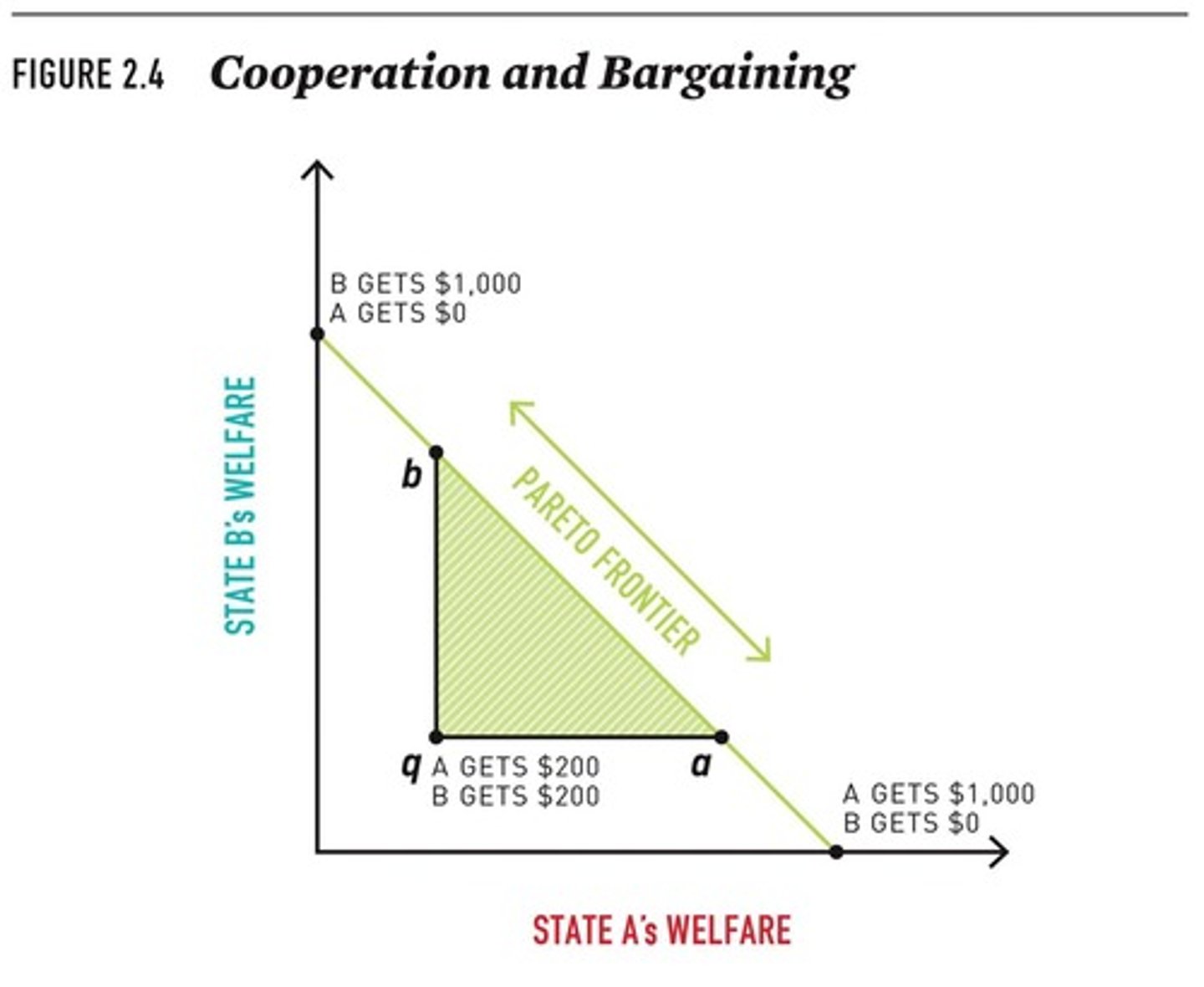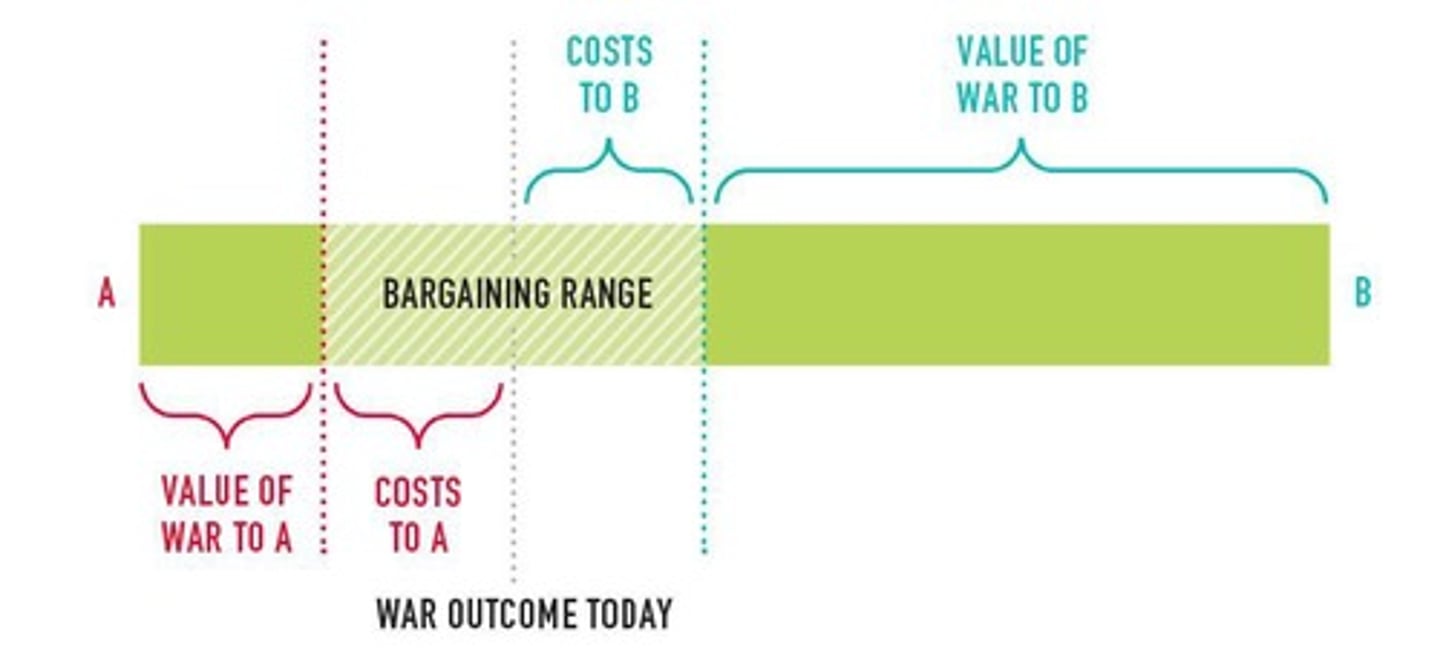Final Exam Review: Key Concepts in International Relations
1/145
There's no tags or description
Looks like no tags are added yet.
Name | Mastery | Learn | Test | Matching | Spaced |
|---|
No study sessions yet.
146 Terms
Sovereignty
Expectation that states have legal and political supremacy within their boundaries.
Anarchy
There is no legal authority higher than or above the state to make and enforce laws that bind international actors.
Institutions
Set of rules (known and shared by community) that structure interactions in specific ways.
Cooperation
Mutual policy adjustments that move actors toward or onto the Pareto frontier, i.e., making at least 1 actor better off without making any other actor worse off.
Collective Action Problem
Smaller groups in which the benefits and costs are more concentrated than in bigger groups.
Coercion
Threat or imposition of costs on other actors to induce change in behavior (by reducing the value of reversion outcome).
Material capabilities
Resources such as guns and money required to exert coercion.
Outside option
Actors can get a better deal when they have attractive outside options.
Reversion outcome
The next-best alternative for the party with the outside option.
Agenda setting
Actions taken before or during bargaining that make the reversion outcome more favorable for one party.
Crisis bargaining
Bargaining that can fail due to incomplete information, commitment problems, or issue indivisibility.
Preventive war
A war fought with the intention of preventing an adversary from becoming stronger in the future.
Treaty of Westphalia
Ended the Thirty Years' War and enshrined the concept of sovereignty, laying the foundation of the modern state system.
Pareto frontier
A situation where at least one actor is better off without making any other actor worse off.

Negative externalities
Costs incurred by third party actors who are not involved in a cooperative action.
Status quo
The existing state of affairs before any changes are made.
Customary international law
Informal institutions that are based on established practices and norms.
UN
United Nations, an example of a formal institution.
WTO
World Trade Organization, an example of a formal institution.
Deregulation
Taking unilateral actions to alter the options available to others, as seen in the US airline industry.
Bargaining
The process of negotiation between parties to reach an agreement.
Shifting Power
A state whose power is increasing cannot commit not to exploit that power in future bargaining.
Rally Effect
People's tendency to become more supportive of their country's government in times of dramatic international events.
In-group/out-group explanation
Greater attachment and loyalty to in-group (fellow country men/women) when experiencing conflict with outsiders.
Democratic Peace
Pair of democratic states rarely, if ever, fight one another.
Democratic accountability
Elections are ways voters can punish leaders for their decisions, and expectations of backlash can tame leaders' warring tendencies.
Autocratic accountability
Leaders held accountable by 'selectorate' or groups of people whose support is necessary for a leader to retain office.
Bargaining Range
The range within which two parties can negotiate an agreement.

Collective Security Organization (CSO)
Member states to the UN can be called to act against an aggressor.
Peace Enforcement
Intervention during conflict to help end conflict and protect civilians.
Peace Keeping
After conflict, ensuring that war does not restart by helping enforce ceasefire/peace agreements.
Costs of War
Costs of war are paid by people who fight, suffer economic hardship of wars, and pay higher taxes to support the war effort.
Scapegoating
Allowing leaders to blame foreigners for the country's problems.
Credibility in Alliances
Deterrence only works if A and B believe that C would intervene in the event of war.
Bargaining Failure
Occurs when there is uncertainty about C's eventual behavior, leading B not to believe C's threat of intervention.
Intervention Response
Response ranges from economic sanctions to full-scale military intervention against an aggressor.
Economic Growth Rates
Different rates of economic growth can shift power dynamics between states.
New Weapons & Technologies
Advancements in weaponry and technology can alter the balance of power.
Government Dissent
Government cracking down on dissenting opinions during conflicts.
National Sentiment
The collective feelings of a nation, often magnified during times of conflict.
Military Intervention
The act of a state using military force to influence the course of events in another state.
Impartiality in Peace Keeping
Peacekeeping forces are impartial and do not take sides.
Heavily armed
Not armed, can't intervene (e.g., Rwanda)
Resource from P5
Resources from P5, as authorized by UNSC
Resource from non-P5
Resources from non-P5, forces with weak interests in the conflict
External imposed on warring parties
Host nation agreement: government must consent to host peacekeeping forces
Overcoming collective action problem (1/5)
Social Factors: Wood (2003): motivation by a sense of justice and desire to do something meaningful erases rational actors' incentive to free ride.
Overcoming collective action problem (2/5)
Selective Incentives/Compensations: Rebel leaders can distribute selective incentives (Popkin 1979, Lichback 1994).
Overcoming collective action problem (3/5)
Forced recruitment and kidnapping.
Overcoming collective action problem (4/5)
Survival: Participation as combatant helps increase chances of survival compared to non-participation (Kalyvas & Kocher 2007).
Overcoming collective action problem (5/5)
Extreme Ideologies: Walter (2017): resolve collective action problem by offering deferred compensation (reward of the eternal afterlife).
Country-level risk factors
Regime types: Democracies allow for peaceful ways to redress grievances through existing political channels.
Counter insurgency
Indiscriminate violence on civilian population that might be sympathetic to the rebel's cause.
Stolper-Samuelson
Protection benefits the scarce factor of production.
Ricardo-Viner (specific factors)
Assumes that factors of production are tied to their industry, AKA industry-specific.
Representation of Interests Through Political Institutions
Constituency Size: Even in democracies, size of constituency matters for how a politician designs trade policies.
Small constituencies
Much more responsive to local industrial interests, parochialistic.
US Congress trade policy authority
US Congress has constitutional authority to make trade policy, which is very protectionist.
Smoot-Hawley Trade Act
A 1930 act where every Congressmember sought to impose higher tariffs to benefit their domestic industries.
National constituency
Less need to cater to specific local interests, more universalistic, focusing on aggregate welfare improvement of reducing trade barriers.
1934 US Congress delegation
US Congress delegated trade policy making authority to the President, allowing him to pursue reciprocal trade policies.
Trade Adjustment Assistance (TAA)
A compensation program in the US that includes training, income support, and relocation allowances.
TAA petition process
Petitions must be filed and certified by the Department of Labor after a statutory 40-day investigation period.
Bureaucratic certification bias
Bureaucrats are less likely to certify TAA petitions and more likely to delay investigations during Republican presidencies relative to Democratic presidencies.
Voter trust and certification
Lengthy certification periods can reduce voters' trust in the government's ability to protect them from adverse consequences of international trade.
GATT/WTO
International institutions that promote cooperation on trade and help enforce international trade law.
World Bank
Provides concessional aid to countries.
IMF
Used to monitor and manage exchange rates, but became the lender of last resort to bail countries out of defaulting on their debt.
Reciprocity
The principle of exchanging concessions in lowering tariff barriers that are important to each other's producers.
Most favoured nation status
In GATT/WTO, a rate negotiated by a couple of countries with their biggest trade partners that applies to all members.
Bound vs Applied vs Preferential Rates
Different types of tariff rates applied in international trade agreements.
Ad Valorem Rates
Tariff rates expressed as a percentage of the value of the goods.
Investing abroad
Investors move money from capital-rich to capital-poor countries for higher profit rates/interest rates.
Heckscher-Ohlin theory
A theory stating that in countries with a scarcity of capital, capital is more expensive, leading to higher interest rates.
Debt repayment importance
Repaying one's debt is crucial for credibility and future investment opportunities.
Government austerity measures
Actions required by a debtor government to repay debt, such as raising taxes and reducing government services.
Concessional finance
Lending from government agencies and IGOs at below market interest rates to developing countries.
Concessional loans
Loans provided to borrowers who cannot borrow from private creditors, often reflecting economic and political motivations.
IGO lenders
International governmental organizations like the World Bank that provide loans with less direct political influence.
Role of Multinational Corporations
Invest abroad and establish overseas affiliates to gain access to local market, take advantage of local resources, reduce transport costs, avoid trade barriers, and better access to market information.
Affiliates in low-income countries
Make intensive use of labor-abundant factors and higher skilled portions of the production network because they think it is profitable.
Appreciated currency
More expensive for foreigners to buy the country's goods and services, leading to reduced exports.
Depreciated currency
Cheaper for foreigners to buy the country's goods and services, leading to increased exports.
Fixed exchange rate
Offers stability and predictability in currency value.
Floating exchange rate
Provides flexibility and autonomy in currency value.
Resource Curse
Abundance in natural resources can lead to a focus on exporting commodities, creating institutions that bias against popular participation, and lower investment in people, resulting in poverty.
Example of Resource Curse
Zambia's copper wealth leads to low incentive to invest in the productive capacity of the populace.
Property Rights
Protection of property rights leads to investment in economic activities, such as innovation in machinery, which drives economic growth.
Secure property rights
Ensure that a property owner can be confident that their material goods will not be seized arbitrarily.
Import-substituting Industrialization (ISI)
Pursued by most developing countries from 1930s-1980s to reduce imports and encourage domestic manufacturing.
Trade barriers in ISI
Protect domestic manufacturers from foreign competition.
Weaknesses of ISI
Inefficient industries and difficulty selling products abroad make them vulnerable to crises.
Export-Oriented Industrialization (EOI)
An alternative to ISI, where countries like South Korea, Taiwan, Singapore, and Hong Kong encourage manufacturers to produce for foreign consumers.
EOI Policies
Include low-cost loans, tax breaks for exporters, and maintaining a weak currency to make products artificially cheap.
International Law
A body of rules that binds states and other agents in world politics and is considered to have the status of law.
Primary rules
Negative and positive rules regulating behavior, such as prohibitions and obligations.
Secondary rules
Rules that structure the making of primary rules, akin to a constitution.
Rule of Law
To be governed by the 'rule of law' is to set and enforce primary rules in ways that are consistent with secondary rules.
Obligation
Degree to which states are legally bound by an international rule.
High Obligation
Obligated to comply in good faith; if breached, require reparations to the injured party.